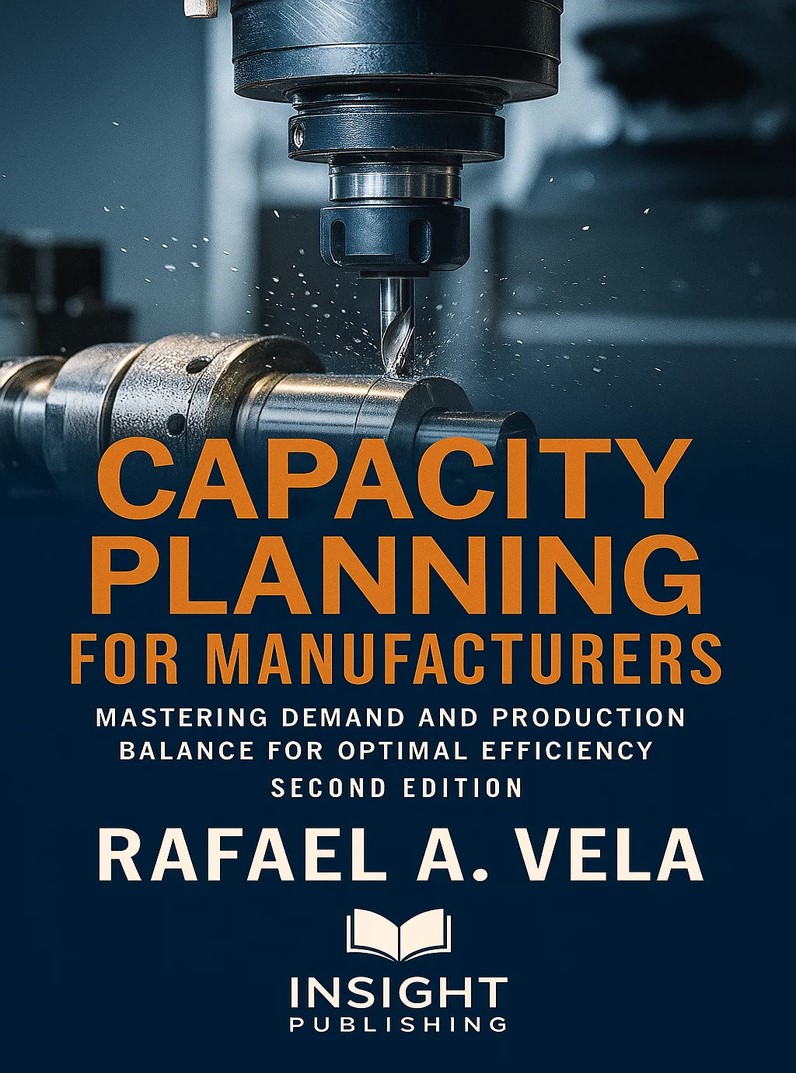
Capacity Planning for Manufacturers - Mastering Demand and Production Balance for Optimal Efficiency - Second Edition - 164 pages
Are your production lines constantly bottlenecked, leaving you with late orders and frustrated customers?
In manufacturing, the imbalance between customer demand and production capacity is the silent killer of profitability. It leads to wasted resources, missed deadlines, and lost business. Juggling limited resources and unpredictable orders is not a strategy; it's a path to burnout and unsustainable growth.
"CAPACITY PLANNING FOR MANUFACTURERS" is your practical blueprint for mastering this critical balance. This isn't just a book about theory; it's a hands-on guide that gives you the system to move from reactive firefighting to proactive, data-driven planning.
In this comprehensive second edition, you will discover how to:
- Accurately forecast demand to prevent costly stockouts and overproduction.
- Eliminate production bottlenecks and smooth out your workflow for maximum output and profitability.
- Make data-driven decisions that optimize your workforce and equipment, ensuring you're never under- or over-resourced.
- Consistently meet customer needs and build a reputation for reliability, turning satisfied customers into long-term partners.
Stop letting fluctuating demand control your business.
Get your copy today and build a manufacturing operation that is both efficient and prepared for sustainable growth.
Table of contents:
Chapter 1: Fundamentals of Capacity Planning - 11
- Defining Capacity in Manufacturing - 11
- Types of Capacity: Design, Effective, and Actual - 11
- Key Concepts in Capacity Management - 14
Chapter 2: Assessing Current Capacity - 16
- Conducting a Capacity Audit - 16
- Identifying Bottlenecks and Constraints - 18
- Tools for Measuring Capacity Utilization - 19
Chapter 3: Forecasting Demand - 23
- The Role of Demand Forecasting in Capacity Planning - 23
- Methods for Accurate Demand Prediction - 27
- Aligning Forecasts with Capacity Needs - 28
Chapter 4: Types of Capacity Planning - 33
- Lead Capacity Planning - 33
- Lag Capacity Planning - 40
- Match Capacity Planning - 48
Chapter 5: Creating a Capacity Plan - 58
- Steps to Develop a Capacity Plan - 58
- Short-Term vs Long-Term Planning - 61
- Tools and Techniques for Planning - 70
Chapter 6: Balancing Capacity and Demand - 76
- Strategies for Balancing Production with Demand - 76
- Managing Production Schedules and Lead Times - 78
- Understanding Production Schedules - 78
- Managing Lead Times - 79
- Balancing Production Schedules and Lean Times - 81
- Overcoming Seasonal and Fluctuating Demand - 82
Chapter 7: Resource Allocation and Optimization - 84
- Allocating Resources for Maximum Efficiency - 84
- Managing Labor, Equipment, and Materials - 92
- Techniques for Resource Optimization - 94
Chapter 8: Managing Capacity Constraints - 97
- Identifying and Mitigating Capacity Constraints - 97
- Lean Manufacturing Principles for Capacity Management - 99
- The Role of Technology in Overcoming Constraints - 100
Chapter 9: Capacity Planning for Different Types of Manufacturing - 103
- Discrete Manufacturing vs. Process Manufacturing - 103
- Capacity Planning in Make-to-Order and Make-to-Stock Environments - 105
- The Role of Customization in Capacity Planning - 107
Chapter 10: The Impact of Maintenance on Capacity Planning - 109
- Preventative Maintenance and Capacity - 109
- Planning for Downtime and Breakdowns - 110
- Managing Capacity During Maintenance Periods - 112
Chapter 11: Using Technology for Effective Capacity Planning - 114
- Enterprise Resource Planning (ERP) Systems and Capacity Management - 114
- Software Solutions for Capacity Planning - 116
- Data Analytics in Capacity Decision Making - 117
Chapter 12: Measuring Capacity Planning Success - 119
- Key Performance Indicators (KPIs) for Capacity Management - 119
- Tracking and Analyzing Capacity Utilization - 122
- Continuous Improvement in Capacity Planning - 123
Conclusion - 126
- The Future of Capacity Planning in Manufacturing - 126
- Final Thoughts on Ensuring You Can Meet Demand - 126
Appendices - 128
- Appendix A: Applying Lean Manufacturing to Improve Capacity Utilization - 129
- Appendix B: Capacity Buffering: Strategies for Managing Fluctuations - 133
- Appendix C: Scenario Planning for Effective Capacity Management - 138
- Appendix D: The Hidden Costs of Overproduction and Its Impact on Capacity - 143
- Appendix E: The Role of ERP Systems in Optimizing Capacity - 147
- Appendix F: Time Series Forecasting Methods for Capacity Planning - 152
- Appendix G: Understanding the Theory of Constraints in Capacity Management - 156
- Appendix H: Bibliography and Suggested Reading - 161
